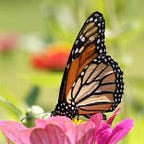Discussion Questions for Flight Behavior
This January, we shared Flight Behavior by Barbara Kingsolver as our quarterly selection to start us off this new year! We have written a list of discussion questions for you to think through as you read along with us and will be talking about a few of these questions in depth on our upcoming Book Discussion via Zoom on Thursday, February 17th at 3 PM ET. Use this Meeting ID: 161 487 0877 and Passcode: 3qY9sYM$S9 to join. Feel free to also use these questions as a springboard for discussions with your friends, colleagues, or local book club.
- In Flight Behavior, some call the monarchs a miracle. Others are alarmed by the presence of the monarchs. Many see economic opportunity. How do the different responses to the monarchs’ appearance in Feathertown, Tennessee speak to the different circumstances of the local people and of the visiting scientists?
- From the main premise of the book to specific details like the landslide the Delgado family fled in Angangueo, Kingsolver weaves together real events and scientific fact with a dramatic fictional depiction of community and a family. What does Kingsolver accomplish by doing this? Where does Flight Behavior succeed or fall short in communicating science?
- What did you think of Flight Behavior’s portrayal of the media’s treatment of Dellarobia and of the monarch phenomenon? Are we still in an era where “…every environmental impact story has to be made into something else”? (pg. 230)
- Dr. Ovid Byron and his team included Dellarobia while counting butterflies and showed her some of their research. On page 145 it states, “His manner was plain and very kind guiding her into comprehension,” which helped her understand. How did Dr. Ovid’s communication style help to cross social and cultural barriers? Have you had experiences with the public that made you relate to Dr. Ovid Byron and his team?
- What did you think about this book’s commentary on class, rural communities, and the divide between scientists and non-scientists?
Brought to you by the USFWS Library, America’s Wild Read is a virtual book club where we aim to inspire you to connect with the outdoors and nature through literature. We hope you will read along with us as we feature various conservation books every quarter — contemporary, traditional, new, and classic.
